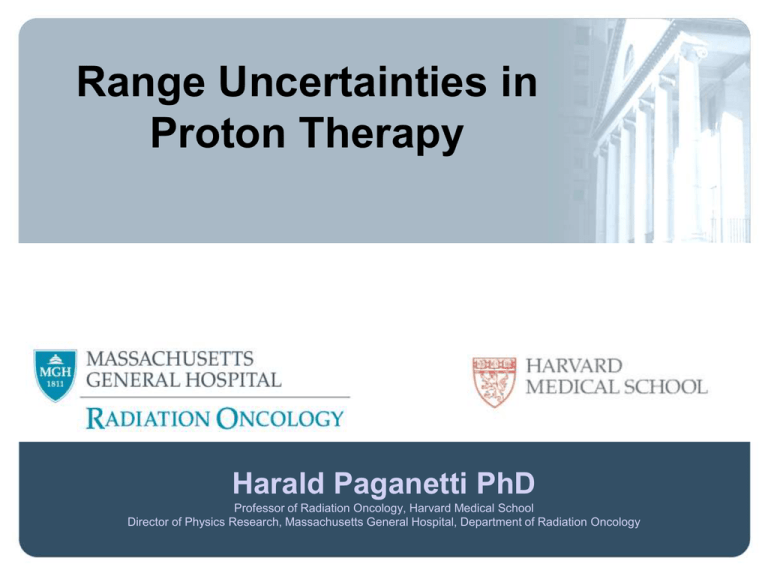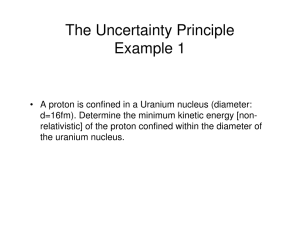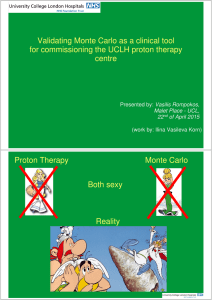Range Uncertainties in Proton Therapy Harald Paganetti PhD
advertisement

Range Uncertainties in Proton Therapy Harald Paganetti PhD Professor of Radiation Oncology, Harvard Medical School Director of Physics Research, Massachusetts General Hospital, Department of Radiation Oncology Proton Beam Range Medulloblastoma Protons Photons Copyright© MGH/NPTC 2003 Proton Beam Range Uncertainty The difference compared to photon therapy: range uncertainties Proton Beam Range Uncertainty In proton therapy, generic homogeneous PTV margin recipes are typically not sufficient ! Proton Beam Range Uncertainty Applied range uncertainty margins for non-moving targets H. Paganetti: Phys. Med. Biol. 57, R99-R117 (2012) Proton Beam Range Uncertainty Range uncertainties sometimes limit our ability to exploit the end of range Example: Prostate treatments Proton Beam Range Uncertainty Protons and Prostate Treatments Current technique: Lateral fields Use lateral penumbra (10 mm, 50-95%) to spare rectum (penumbra not better than 15 MV photon fields) Why not AP fields? Use much sharper distal penumbra (~ 4 mm, 50-95%) AP LAT © Hsiao-Ming Lu, MGH Proton Beam Range Uncertainty Range uncertainty margins for non-moving targets Source of range uncertainty in the patient Independent of dose calculation: Measurement uncertainty in water for commissioning Compensator design Beam reproducibility Patient setup Dose calculation: Biology (always positive) CT imaging and calibration CT conversion to tissue (excluding I-values) CT grid size Mean excitation energies (I-values) in tissue Range degradation; complex inhomogeneities Range degradation; local lateral inhomogeneities * Total (excluding *) Total H. Paganetti: Phys. Med. Biol. 57, R99-R107 (2012) Range uncertainty ± 0.3 mm ± 0.2 mm ± 0.2 mm ± 0.7 mm + 0.8 % ± 0.5 % ± 0.5 % ± 0.3 % ± 1.5 % - 0.7 % ± 2.5 % 2.7% + 1.2 mm 4.6% + 1.2 mm Proton Beam Range Uncertainty Range degradation Type I (Sawakuchi et al., 2008) Proton Beam Range Uncertainty Range degradation Type II (Paganetti et al., 2008) analytical Monte Carlo Proton Beam Range Uncertainty Range uncertainty margins for non-moving targets 2.7%+1.2mm ‘bad’ beam angle in complex geometry ‘typical’ scenario H. Paganetti: Phys. Med. Biol. 57, R99-R117 (2012) Range and Hetereogeneities Heterogeneity Index based on patient geometry relative to pencil kernel M. Bueno, H. Paganetti, M.A. Duch, J. Schuemann: An algorithm to assess the need for clinical Monte Carlo dose calculation for small proton therapy fields. Med Phys 2013 Range and Hetereogeneities Avoiding density heterogeneities ‘Standard’ plan Applied plan Field Gantr y angle Table angle Density heterogene ity index Gantr y angle Table angle Density heterogene ity index 1 -45 -90 20.4 -90 -120 28.2 2 -10 0 12.9 -90 -60 30.2 3 -120 -120 12.7 60 0 26.2 Frequency (number of Voxels) 25000 Applied plan 'Standard' plan 20000 15000 10000 5000 0 -20 © T. Lomax (PSI) -15 -10 -5 0 5 Dose difference 10 15 20 Range and Hetereogeneities In addition(!): patient geometry changes Example: Intra-fractional geometry changes Before RT After RT • Parotid glands • Subm.glands • Tumor E. M. Vasques Osorio et al. IJROBP 70: 875-82 Range and Hetereogeneities In addition(!): patient geometry changes • Patient weight gain / loss • Filling up of sinuses • (Sub-clinical) pneumonia • Wet hair / gel / hairspray © Lei Dong, MDACC Proton Beam Range Uncertainty Lung • Dose fall-off often in lung tissue (density ~0.25-0.3) -> range differences magnified by factor 3-4 Pencil Beam Monte Carlo Difference - 100% prescribed dose - 10% - -10% Motion Photons Protons Isodose levels 20 50 80 95 100 © Engelsman, MGH Motion Photons Protons Isodose levels 20 50 80 95 100 © Engelsman, MGH Motion Transversal Coronal Sagittal dose delivered over time cumulative dose Addressing range uncertainties Source of range uncertainty in the patient Independent of dose calculation: Measurement uncertainty in water for commissioning Compensator design Beam reproducibility Patient setup Dose calculation: Biology (always positive) CT imaging and calibration CT conversion to tissue (excluding I-values) CT grid size Mean excitation energies (I-values) in tissue Range degradation; complex inhomogeneities Range degradation; local lateral inhomogeneities * Total (excluding *) Total Range uncertainty ± 0.3 mm ± 0.2 mm ± 0.2 mm ± 0.7 mm + 0.8 % ± 0.5 % ± 0.5 % ± 0.3 % ± 1.5 % - 0.7 % ± 2.5 % 2.7% + 1.2 mm 4.6% + 1.2 mm Monte Carlo dose calculation ± 0.2 % ± 0.1 % ± 0.1 % 2.4 % + 1.2 mm H. Paganetti: Range uncertainties in proton beam therapy and the impact of Monte Carlo simulations Phys. Med. Biol. 57: R99-R117 (2012) Addressing range uncertainties 4 mm gain ! H. Paganetti: Range uncertainties in proton beam therapy and the impact of Monte Carlo simulations Phys. Med. Biol. 57: R99-R117 (2012) Addressing range uncertainties Addressing range uncertainties Head & Neck Patient Proton Dose_XiO 4 Head&Neck_patient_dose 8 2 7 1 0 -1 -2 6 5 4 3 -3 2 -4 1 -5 RMSD: 3mm - 7mm 9 3 Dose_Difference Head&Neck_patient_dose 10 Avg. diff.: [-5mm ; 3mm] RMSD (mm) Avg. range difference (mm) 5 Proton Dose_TOPAS 0 P1 P2 P3 P4 P5 P6 P7 P8 Patient number P9 P10 P11 P12 P1 P2 P3 P4 P5 P6 P7 P8 Patient number P9 P10 P11 P12 Addressing range uncertainties © H.-M.Lu (MGH) 1 Balloon with detector array embedded on the surface 2 Deliver dose (< 1 cGy) for 500 ms using a few cm of extra beam range to cover dosimeters 3 Measure dose rate functions by a multi-channel electrometer 4 Match data (pattern matching) to determine WEPL at dosimeters and adjust beam range 5 Commence treatment Addressing range uncertainties Mitigating range uncertainties using robust planning in IMPT Beam 1 Total dose: © Unkelbach, MGH Beam 2 Beam 3 Addressing range uncertainties Mitigating range uncertainties using robust planning in IMPT Beam 1 Total dose: © Unkelbach, MGH Beam 2 Beam 3 Conclusion • Range uncertainties in proton therapy can be substantial (i.e. several mm) • Advanced dose calculation only solves part of the problem • Robust planning can mitigate the impact of range uncertainties • Proton treatment planning needs to be done by experienced planners who understand the impact of range uncertainties • For some sites (e.g. prostate) range uncertainties prevent us from exploiting the full potential of proton therapy • In vivo range verification is highly desirable





